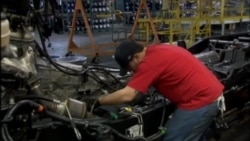The U.S. economy added 214,000 jobs in October, which pushed the unemployment rate down a tenth of a percentage point to 5.8 percent, its lowest point since June 2008. But the job market is still not where it needs to be for millions of Americans.
Manufacturing expanded at its fastest pace in three years in October, and the service sectors — retailers and restaurants — continued to grow at a healthy pace.
President Barack Obama noted that the economy has gained more than 200,000 jobs a month for nine straight months.
“Our private sector has now added 10.6 million new jobs over the last 56 months, and this is the strongest job growth that we have seen since the 1990s," he said.
But the numbers mask a persistent problem for many Americans: underemployment.
“In this report we see that there were 9 million people unemployed, (and) another 7 million people were working part time who’d like to have full-time work," said Mark Hamrick, Washington bureau chief at Bankrate.com. "So that tells us that combined, the number of unemployed and underemployed is still 16 million. That’s a lot of people.”
Despite recent gains, Hamrick said, persistent underemployment and stagnant wage growth may account for the voter dissatisfaction on Tuesday that gave the Republican Party majority control of both houses of Congress.
“When Americans are not making progress on their incomes, when they’re seeing wage increases that are barely remaining above the pace of inflation, they feel like their economic well-being is not on the rise and they worry about the way the future may present itself,” Hamrick said.
Average hourly earnings grew only 3 cents last month. And in an economy as consumer-driven as that of the United States, said economist Cary Leahey of the research group Decision Economics, that's not a recipe for growth.
“Until you see wages, you’re not going to see consumer spending, and until you see consumer spending, you’re not really going to have a strong economy,” Leahey said.
Other data were more upbeat.
The labor force participation rate, or the share of working-age Americans who are employed or at least looking for a job, increased by one-tenth of a percentage point to 62.8 percent, bouncing back after two straight months of declines.
The employment-to-population ratio increased to 59.2, the highest level since 2009.
And a broad measure of joblessness — which includes people who want to work but have given up searching and those working part time because they cannot find full-time employment — fell to 11.5 percent, the lowest level since September 2008.
Despite the string of positive economic news, analysts said there was little in the report to get Wall Street excited — even less reason for the Federal Reserve to raise interest rates anytime soon.












